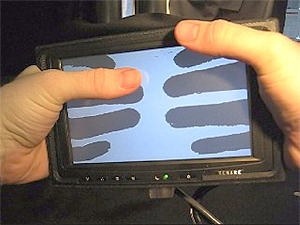lucid touch microsoft research & mitsubishi electric research labs
|
up patrick baudisch |
| visitor |
I am currently working on a miniaturized version of the device ("nanoTouch") in collaboration with Gerry Chu.
Touch is a compelling input modality for interactive devices; however, touch input on the small screen of a mobile device is problematic because a user’s fingers occlude the graphical elements he wishes to work with. LucidTouch is a mobile device that addresses this limitation by allowing the user to control the application by touching the back of the device. The key to making this usable is what we call pseudo-transparency: by overlaying an image of the user’s hands onto the screen, we create the illusion of the mobile device itself being semitransparent. This pseudo-transparency allows users to accurately acquire targets while not occluding the screen with their fingers and hand. LucidTouch also supports multi-touch input, allowing users to operate the device simultaneously with all 10 fingers. We present initial study results that indicate that many users found touching on the back to be preferable to touching on the front, due to reduced occlusion, higher precision, and the ability to make multi-finger input.
or download this
![]() video in
AVI format
video in
AVI format
See the initial design sketches:
application scenarios.
|
|
Wigdor, D., Forlines, C., Baudisch,
P., Barnwell, J., Shen, C. |
Popular press
|
|
Griffith, E. Future Tech: Seven Innovations That Will Change Your Life
#4: LucidTouch.
In PC Magazine, June 6, 2008. |
|
|
Singh, H. Microsoft's TechFest showcased an array of technologies.
In India Times-Economic
times, March
20, 2008. |
|
|
Mintz, J.
Microsoft researchers show off latest.
In Boston Globe, March
18, 2008. |
|
|
Madden, D. Microsoft LucidTouch.
In AV Review, March
18, 2008. |
|
|
Morgenstern, D. Did Microsoft beat Apple to dual-sided touch technology?.
In ZD Net, March
17, 2008. |
|
|
Microsoft Unveils LucidTouch Prototype.
In Do Device, March
15, 2008. |
|
|
Kwan, M. Microsoft LucidTouch Tablet PC Is Semi-Transparent.
In Mobile Magazine, March
13, 2008. |
|
|
Davies, C. Microsoft Research LucidTouch demos ‘pseudo-transparent’ device.
In Phone Mag, March
13, 2008. |
|
|
LucidTouch control-from-behind touch tech still in development, gorgeous mockup shown.
In DVice, March, 2008. |
|
|
Torkington, N. Radar Roundup: UI.
In O'Reilly Radar, March
11, 2008. |
|
|
LucidTouch Multi-Touch Transparent Mobile Device. In Dance with Shadows, March
10, 2008. |
|
|
Morgenstern, S.
A Cure for Fat Fingers. In Popular Science, March
10, 2008. |
|
|
Touch screens to go transparent.
In India Times, March
8, 2008. |
|
|
LucidTouch – the see-through mobile device.
In GizMag, March
7, 2008. |
|
|
Gaudin, S. In Pictures: Microsoft exposes its research efforts.
In Computer World, March 6, 2008. |
|
|
Canwest News Service. Business Browser.
In Edmonton Journal, March
5, 2008. |
|
|
TechFest: Neues aus dem Hause Microsoft Research.
In PC Games Hardware, March
5, 2008. |
|
|
LucidTouch: the “reverse iPhone” concept.
In Uber Gizmo, March
5, 2008. |
|
|
Caizergues, M. TechFest: les chercheurs Microsoft présentent l'interface LucidTouch.
In LeMondeInformatique, March
5, 2008. |
|
|
Romano, B.J. One big science fair for hundreds of Ph.D.s.
In Seattle Times, March
5, 2008. |
|
|
Bishop, T. TechFest takes a worldview.
In Seattle PI, March
5, 2008. |
|
|
Gardiner, B. Microsoft LucidTouch Gives Touch Technology the 'Reach Around'.
In Wired, March
4, 2008. |
|
|
Miles, S. Microsoft LucidTouch concept shown off. Work your magic on the screen from behind.
In PocketLint, March
4, 2008. |
|
|
Goring, N. Microsoft's cutting edge on display at TechFest.
In InfoWorld, March
4, 2008. |
|
|
Boyle, A. Science Fair For Grown-Ups.
In MSNBC, March
4, 2008. |
|
|
Anthes, J. Give your computer the finger: Touch-screen tech comes of age.
In ComputerWorld, February
1, 2008. |
|
|
Liebman, J. Gadget with a View.
In Portfolio,
January 2008 • 1 Page, in print issue and online. |
|
|
Spencer, K. Under Development
A Peek At What's Brewing In The Laboratory: Touch The Screen On Both Sides Now.
In Computer Power User,
January 2008 • Vol.8 Issue 1
Page(s), pp. 106-107 in print issue. |
|
|
Tortolini, A. Microsoft, Google y
Yahoo! empiezan a mostrar cómo competirán con el iPhone.
In Perfil,
print Edition,
November 11, 2007, pp. 49. |
|
|
Greene, K. A Better Touch Screen.
In Technology Review,
print Edition,
November/December 2007, pp. 15. |
|
|
Sorrel, C. LucidTouch: See Through
Multi Touch Screen. In Wired,
October 12, 2007. |
|
|
CowboyNeal. Touch-based Handhelds Turned Inside Out. In
Slashdot,
October 12, 2007. |
|
|
Barras, C. 'Transparent' gadget could trump iPhone interface. In
New Scientist, October
11, 2007. |
|
|
Fallon, S. "Transparent" Touchscreen: LCD the Front, Fingers in the Back. In
Gizmodo, October 11, 2007. |
|
|
Koesch, S., Magdanz, F. Stadler, R. Handys werden körperlos. In
Spiegel Online,
September 6, 2007. |
|
|
Johnson, S. Multi-touch Display Uses All Ten Fingers.
In Internet News,
August 24, 2007. |
|
|
Oiaga, M. Windows Aero Is Old News – Introducing LucidTouch User Interface.
In Softpedia News,
August 24, 2007. |
|
|
Topolskye, J. Microsoft R&D strikes again: the LucidTouch.
In Engadget,
August 24, 2007. |
|
|
Greene, K. Two-Sided Touch Screen.
In Technology Review,
August 24, 2007. |
In collaboration with Daniel Wigdor (MERL), Clifton Forlines (MERL), John Barnwell (MERL), and Chia Shen (MERL)
